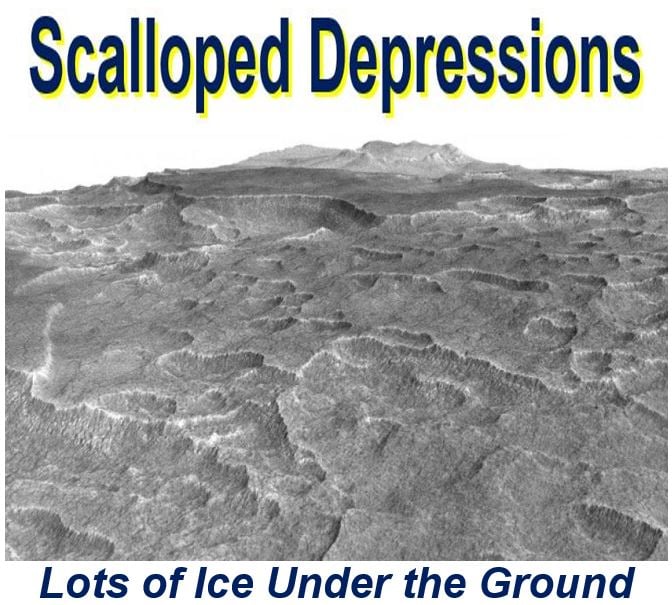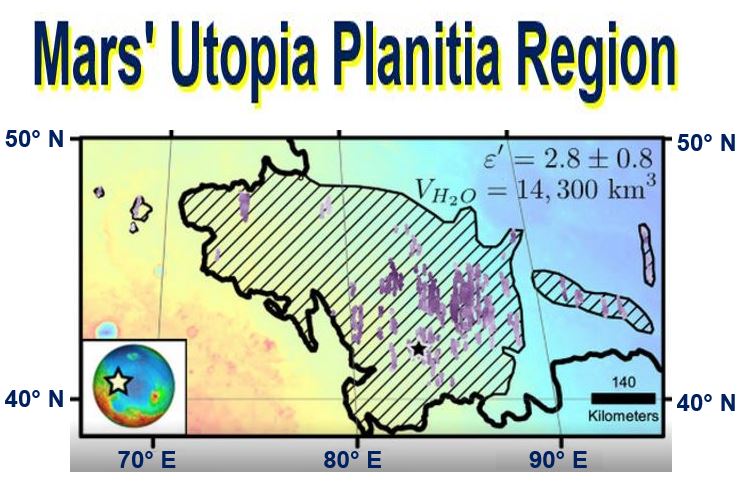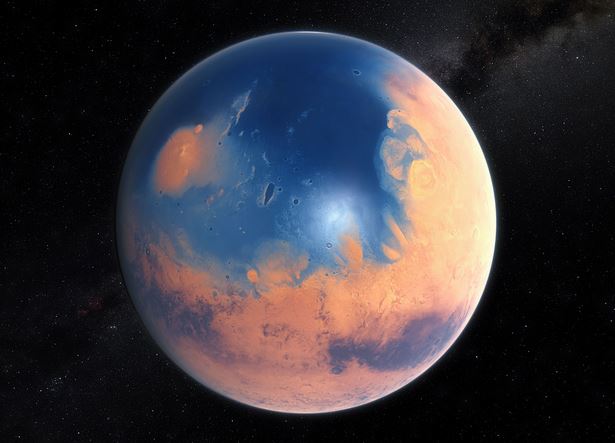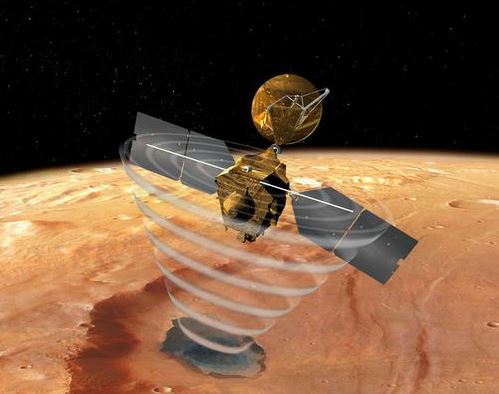There is more underground water in the form of ice in a region of Mars than in the whole of Lake Superior, the largest of North America’s Great Lakes, say scientists from The University of Texas at Austin after analyzing data from NASA’s Mars Reconnaissance Orbiter and discovering a huge ice deposit.
The Utopia Planitia region of Mars lies in the mid-northern latitudes. The orbiter’s ground-penetrating Shallow Radar (SHARAD) instrument was studied by a team of scientists. They published details on their study and ice deposit findings in the journal Geophysical Research Letters.
After analyzing data from over six-hundred overhead passes, they concluded that there was an ice deposit larger than the whole state of New Mexico. It ranges in thickness from 260 to approximately 560 feet (79 to 170 meters), composed of 50% to 85% water ice, with dust or larger rocky particles mixed in.
 Two images showing SHARAD (Shallow Radar) instrument data from two tracks in a part of the Utopia Planitia region, Mars, where the orbiting, ground-penetrating radar on NASA’s Mars Reconnaissance Orbiter detected underground water ice deposits. (Image: news.utexas.edu. Credit: NASA/JPL-Caltech/University of Rome/ASI/PSI)
Two images showing SHARAD (Shallow Radar) instrument data from two tracks in a part of the Utopia Planitia region, Mars, where the orbiting, ground-penetrating radar on NASA’s Mars Reconnaissance Orbiter detected underground water ice deposits. (Image: news.utexas.edu. Credit: NASA/JPL-Caltech/University of Rome/ASI/PSI)
Ice deposit protected by Martian soil
At the latitude of this vast underground frozen water deposit – approximately halfway from the equator to the pole – water is unable to persist on the surface of the Red Planet today. In Mars’ thin, dry atmosphere, it turns into water vapor.
The Utopia ice deposit is under Martian soil, ranging from 3 to 33 feet (0.9 to 10 meters) in thickness.
Lead author, Cassie Stuurman, a graduate student at the University of Texas Institute for Geophysics, a Jackson School of Geosciences unit, said:
“This deposit probably formed as snowfall accumulating into an ice sheet mixed with dust during a period in Mars history when the planet’s axis was more tilted than it is today.”
Utopia Planitia in English means ‘plains of paradise’. The recently-surveyed ice deposit spans latitudes from 39 to 49 degrees within the plains.
 In this vertically-exaggerated view, you can see the scalloped depressions, which prompted scientists to check for underground ice. They used ground-penetrating radar aboard NASA’s Mars Reconnaissance Orbiter. More frozen water than the volume of Lake Superio was found. (Image: news.utexas.edu. Credit: NASA/JPL-Caltech/University of Arizona)
In this vertically-exaggerated view, you can see the scalloped depressions, which prompted scientists to check for underground ice. They used ground-penetrating radar aboard NASA’s Mars Reconnaissance Orbiter. More frozen water than the volume of Lake Superio was found. (Image: news.utexas.edu. Credit: NASA/JPL-Caltech/University of Arizona)
Mars has lots of frozen water
Mars is believed to have a considerable amount of water. This latest discovery probably represents less than 1% of all the water ice on the Red Planet. However, it now has more than twice as much thick, buried ice sheets in the northern plains than we thought it had.
NASA, ESA (European Space Agency), Roscosmos (Russian Space Agency), and other space agencies around the world say that any ice deposit near the surface of Mars could be used as a resource for astronauts.
This ice deposit more accessible
Co-author Jack Holt, a SHARAD co-investigator who works as a research professor at the University of Texas Institute for Geophysics, said:
“This deposit is probably more accessible than most water ice on Mars, because it is at a relatively low latitude and it lies in a flat, smooth area where landing a spacecraft would be easier than at some of the other areas with buried ice.”
Prof. Holt had previously used radar to study ice in buried glaciers and the polar caps of Mars.
The Utopian water today is all frozen. If a melted layer existed – which scientists say would be significant for life on the Red Planet – the radar scans would have found evidence of it. Even so, some melting cannot be ruled out during different climate conditions when Mars’ axis was different.
Prof. Holt said:
“Where water ice has been around for a long time, we just don’t know whether there could have been enough liquid water at some point for supporting microbial life.”
 The diagonal striping on the map above shows a portion of Mars’ Utopia Planitia region where a large subsurface of deposit-rich water ice exists. (Image: jpl.nasa.gov. Credit: NASA/JPL-Caltech/Univ. of Rome/ASI/PSI)
The diagonal striping on the map above shows a portion of Mars’ Utopia Planitia region where a large subsurface of deposit-rich water ice exists. (Image: jpl.nasa.gov. Credit: NASA/JPL-Caltech/Univ. of Rome/ASI/PSI)
When Mars was much younger, a large celestial body crashed onto its surface, creating the Utopia Planitia basin, which today has a diameter of approximately 2,050 miles (3,299 km). In 1976, NASA’s Viking 2 Lander was at a site near the center of Utopia.
Ms. Stuurman and colleagues examined an area southwest of where the silent lander still sits.
Co-author Gordon Osinski, from Western University in Ontario, Canada, first thought of using the Italian-built SHARAD instrument. For several years, he and other scientists had been fascinated by ground-surface patterns there, such as the polygonal cracking and rimless pits called scalloped depressions.
Ms. Stuurman, who began this project while studying at Western, said regarding the pattern: “like someone took an ice cream scoop to the ground.”
 An artist’s impression of what Mars was probably like about four billion years ago. Scientists at NASA’s Goddard Space Flight Center in Greenbelt, Maryland, believe that it had a giant ocean that covered 19% of the planet. (Image: ESO)
An artist’s impression of what Mars was probably like about four billion years ago. Scientists at NASA’s Goddard Space Flight Center in Greenbelt, Maryland, believe that it had a giant ocean that covered 19% of the planet. (Image: ESO)
Similar landforms in the Canadian Arctic are indicative of ground ice, Osinski explained, “but there was an outstanding question as to whether any ice was still present at the Martian Utopia or whether it had been lost over the millions of years since the formation of these polygons and depressions.”
The vast volumes of ice detected with SHARAD help scientists better understand Mars’ history, and provide future Mars mission organizers with a valuable resource.
Mars Reconnaissance Orbiter Deputy Project Scientist, Leslie Tamppari, of NASA’s Jet Propulsion Laboratory in Pasadena, California, said:
“It’s important to expand what we know about the distribution and quantity of Martian water. We know early Mars had enough liquid water on the surface for rivers and lakes. Where did it go? Much of it left the planet from the top of the atmosphere.”
“Other missions have been examining that process. But there’s also a large quantity that is now underground ice, and we want to keep learning more about that.”
 An artist’s impression of the Mars Reconnaissance Orbiter’s Radar – SHARAD. (Image: mars.nasa.gov)
An artist’s impression of the Mars Reconnaissance Orbiter’s Radar – SHARAD. (Image: mars.nasa.gov)
Co-author Joe Levy, who works at the University of Texas Institute of Geophysics, said:
“The ice deposits in Utopia Planitia aren’t just an exploration resource. They’re also one of the most accessible climate change records on Mars. We don’t understand fully why ice has built up in some areas of the Martian surface and not in others.”
“Sampling and using this ice with a future mission could help keep astronauts alive, while also helping them unlock the secrets of Martian ice ages.”
Citation: “SHARAD detection and characterization of subsurface water ice deposits in Utopia Planitia, Mars,” C. M. Stuurman, B. A. Campbell, M. Kerrigan, T. C. Brothers, G. R. Osinski, J. S. Levy and J. W. Holt. Geographical Research Letters. 23 November, 2016. DOI: 10.1002/2016GL070138.
Video – Ice Deposit on Mars
One ice deposit in Utopia Planitia has more subsurface water than in the whole of Lake Superior.
